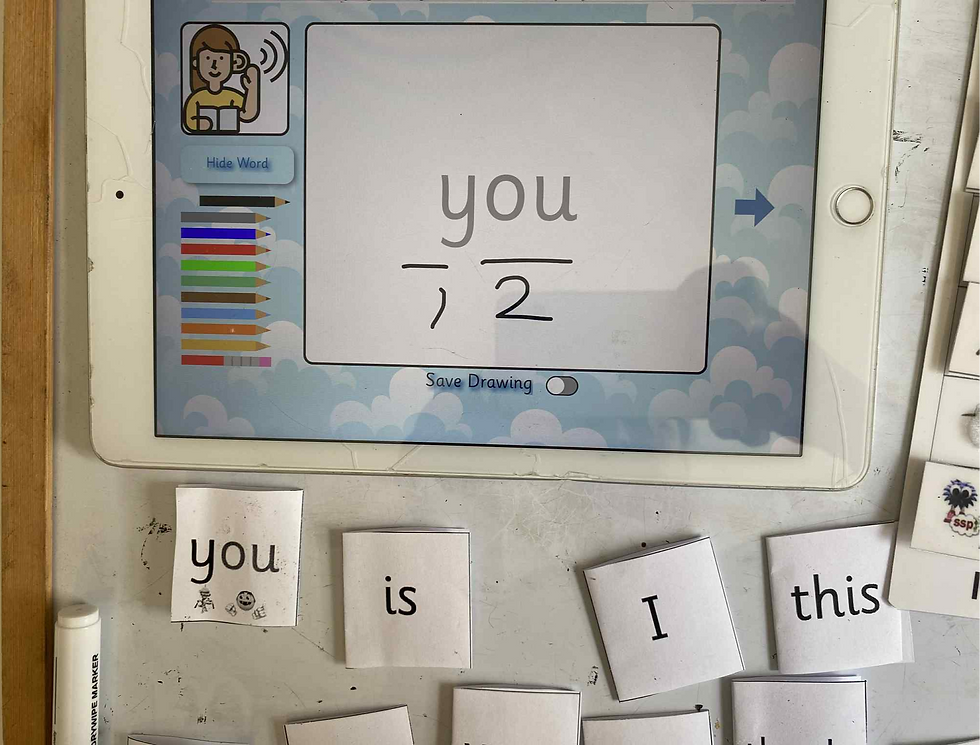
Upstream Screening
in School (R/ KS1)
“Prevention is possible. Upstream screening in Reception gives every child the chance to thrive, long before reading failure is allowed to take hold.”
Emma Hartnell-Baker MEd SEN
The Early Dyslexia Screening Centre.
Director, The Reading Hut Ltd and My SLCN CIC
The Dyslexia Paradox

The dyslexia paradox matters because it exposes the gap between what we know and what we do. Research shows that the risk factors for dyslexia can be identified in the early years, long before phonics instruction begins. This is what we do at the Early Dyslexia Screening Centre. Yet most education systems wait until children have already failed to learn to read before providing targeted support. This support may not be effective if it is more of the same. This delay affects not only literacy but also a child’s confidence, motivation, and sense of belonging in the classroom.
Understanding the dyslexia paradox helps schools and policymakers shift from reaction to prevention. Instead of identifying basic decoding difficulties in the core code at the end of Year 1, or dyslexia after at least three years of struggle, teachers and TAs can screen for the underlying speech sound and mapping difficulties in Reception, when the brain is most responsive to support. We recommend completing the 10-Day Speech Sound Play Plan before starting whole-class phonics, to focus on phonemic awareness and introduce Phonemies (characters that represent English speech sounds).
Early action ensures that children never experience failure as readers and can move into the self-teaching phase with their peers. This is why our work on Speedie Readies and the Ten Minutes a Day with a TA model is so significant. It demonstrates what early, practical prevention looks like in action and begins in Term 2 of Reception.
No More Wait to Fail
The current system is not designed to facilitate self-teaching or to prevent difficulties in learning to read and spell for at least 1 in 4 children within the neurodiverse classroom. The Department for Education expects that whole-class synthetic phonics will lead to fluency and comprehension, yet one in five children does not pass the PSC at the end of Year 1.
Research also shows that passing the PSC does not actually correlate with improved reading comprehension in KS2. Speedie Readies targets decoding with fluency and comprehension.
With growing concern for children who continue to struggle and new testing planned for those not yet reading by Year 8, now is the time to screen for dyslexia risk in Term 1 of Reception and to start prevention in Term 2.
The most effective person to deliver this is the TA. Through the Ten Minutes a Day, With a TA approach, children receive short one-to-one sessions throughout the day with no training or planning required. A Speedie Readies Learning Station can be set up easily, to become the school Three Corners Hub. Children continue with whole-class phonics, but this targeted support rapidly strengthens GPC recognition, blending skills, and exception word knowledge for reading and spelling. Once they begin the One, Two, Three and Away! readers, they quickly engage with the stories and characters and develop a genuine desire to read.
The books are available both online and in print through SpeedieReadies.com and The Reading Hut Bookstore. Schools and families are encouraged to ask local libraries to stock them for home use.
Parents can then easily support their child at home as they read through the series of 100+ books one by one. Pdf for libraries.

The How
How the Speedie Readies Prevention Works from Term 2 of Reception
From Term 2 of Reception, children identified as at risk of reading and spelling difficulties, because of weak phonemic awareness, receive Ten Minutes a Day, With a TA. These short one-to-one sessions require no specialist training or planning. The TA sets up a Speedie Readies Learning Station and works with children individually at convenient moments throughout the day, ideally four times a week. Some children will only need support for a few weeks, while others may benefit from sessions for the whole term.
Each session uses the Monster Spelling Piano app to strengthen recognition of taught GPCs, blending skills, and early spelling until all four Code Levels are mastered. These are the GPCs tested in the PSC.
When children master the Purple Code Level, they begin reading the One, Two, Three and Away! Monster Mapped Readers. These books make the wider orthographic code visible, including the most commonly used high-frequency words. This helps children connect sounds to letters, read with meaning, and develop fluency and comprehension. They become excited about the stories and characters as they explore The Village With Three Corners.
The Teacher Handbook shows how this approach can be extended to provide one-to-one support for every aspect of reading, writing, and spelling. However, the Speedie Readies system is designed to facilitate self-teaching. Many of the difficulties children typically face are resolved naturally as they experience deep reading, the joy of being lost in a book.
This process ensures every child enters the self-teaching phase before the end of Year 1. Once in this phase, they continue to learn more about reading through reading itself, gaining confidence, accuracy, and a lasting love of books.
Ten Minutes, Two Core Activities
The Dual Route to Word Mapping Mastery®
The Core Code + 100 HFWs - Watch Clips




The Village With Three Corners Series - Watch Clips






“A child who never knows the pain of reading failure grows up seeing themselves as capable, curious, and clever. That’s what prevention makes possible.”
Emma Hartnell-Baker, MEd SEN
The Early Dyslexia Screening Centre
Director, The Reading Hut Ltd and My SLCN CIC



